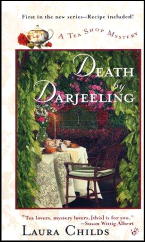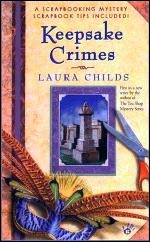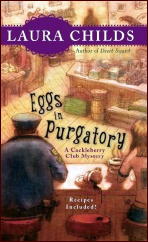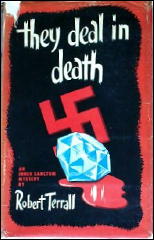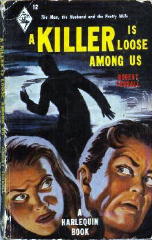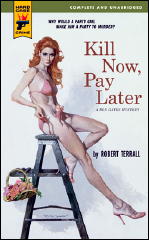May 2009
Monthly Archive
Wed 27 May 2009
LAURA CHILDS – Frill Kill.
Berkley, paperback reprint; 1st printing, October 2008. Hardcover edition: October 2007.
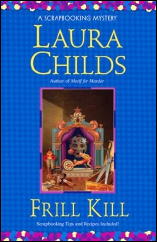
Laura Childs is a one-woman fiction factory. She’s now producing books in three different series, and since 2001, there have been 17 books in those three series, already published or on their way.
I’ll list all of the books at the end of this review. Frill Kill is the fifth one (of seven) in her series “Scrapbooking” mysteries, and from that you can guess, I’m sure, what all of her books are: craft- or food-oriented cozies.
Not that the murder that occurs early on isn’t rather ferocious and gruesome, so much so that werewolvery is suspected, the death being that of a beautiful model shortly before Hallowe’en in downtown (post-Katrina) New Orleans. Strange hair is found at the scene, with the death itself caused by what appears to have been teeth marks.
Finding the body – or more precisely being there at the same time the crime is committed – is Carmela Bertrand, owner of Memory Mine, a small shop specializing in scrapbook making materials – which is a far more extensive line of paper products et cetera than you might suspect.
Aiding and abetting Carmela in her investigation of the crime is not Lt. Babcock, though she does think him rather hunky, but her friend Ava Grieux, who owns the Juju Voodoo shop just across the way. Not helping very much is Carmela’s soon-to-be ex-husband Shamus, whose stuffy family (including himself) is easily shocked by all of the escapades Carmela and Ava get into.
As you might have guessed, descriptions of food (the setting being New Orleans) and the stock at Memory Mine take up a good portion of the book. There is no detection per se – whatever investigating that Carmela and the beautiful Ava do has little bearing on solving the mystery, which is one of those that simply seem to solve themselves, eventually.
No matter. Laura Childs has a flair for fiction that reads smoothly, quickly and enjoyably, with a sure, deft hand on the light-hearted side. This one’s already added substantially, I’m sure, to the ranks of fans that follow her from book to book.
SERIES —
Tea Shop Mysteries
1. Death by Darjeeling (2001)
2. Gunpowder Green (2002)
3. Shades of Earl Grey (2003)
4. English Breakfast Murder (2003)
5. The Jasmine Moon Murder (2004)
6. Chamomile Mourning (2005)
7. Blood Orange Brewing (2006)
8. Dragonwell Dead (2007)
9. The Silver Needle Murder (2008)
10. Oolong Dead (2009)
Scrapbooking Mysteries
1. Keepsake Crimes (2003)
2. Photo Finished (2004)
3. Bound for Murder (2004)
4. Motif for Murder (2006)
5. Frill Kill (2007)
6. Death Swatch (2008)
7. Tragic Magic (2009)
Cackleberry Club Mysteries
1. Eggs in Purgatory (2008)
2. Eggs Benedict Arnold (2009)
Wed 27 May 2009
Posted by Steve under
Reviews[10] Comments
A REVIEW BY MARY REED:
A. E. W. MASON – At the Villa Rose. Hodder, UK, hardcover, 1910. Scribner, US, hardcover, 1910. Four-act play version: Hodder, 1928.

Silent film: Stoll, 1920 [Hanaud: Teddy Arundell; Miss Harland: Manora Thew]. Sound film: Haik, France, 1930, as Mystere de la Villa Rose. Also: Twickenham, 1930 [Hanuad: Austin Trevor; Miss Harland: Norah Baring], aka Mystery at the Villa Rose. Also: ABPC, 1939; released in the US as House of Mystery [Hanaud: Kenneth Kent; Miss Harland: Judy Kelly].
Reprinted many times, both in hardcover and soft, including: Hodder & Stoughton, UK, hc, 1936; Harlequin 460, Canada, pb, 1959 (both shown).
Middle-aged Julius Ricardo is on holiday at Aix-les-Bains. One evening at the casino he notices Celia Harland, beautiful companion to wealthy Madam Camille Dauvray. Rescued from starvation, and probably worse, by her kind-hearted employer, Miss Harland is now romantically involved with rich young Englishman Harry Wethermill.
Both men are staying at the Hotel Majestic, and next morning Wethermill bursts into Ricardo’s room with the news Madam Dauvray has been murdered at the Villa Rose, her confidante and maid Helene Vauquier bound and chloroformed, and Miss Harland, madam’s car, and all her extremely valuable jewelry are gone.
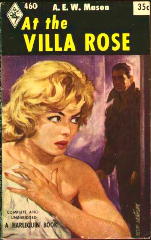
Wethermill insists Inspector Hanaud of the Paris Surete, also holidaying in the town, aid the local authorities with their investigation, not least in finding the missing girl, even though he appears to be the only person who believes her innocent of the terrible crime.
My verdict: Several undercurrents swirl about the villa and red herrings abound. Was the young woman using her skill as a faux medium to hoodwick her employer and if so, why?
How was a vital witness killed in a cab which did not stop in its journey between station and hotel?
What can be deduced from a pair of cushions?
The identity of the murderer is well concealed. There are clews for readers to spot as they go along, but I missed most of them!
Etext: http://www.gutenberg.org/dirs/etext03/vllrs10.txt
Wed 27 May 2009
ROBERT TERRALL – Sand Dollars.
St. Martin’s Press; hardcover; 1st printing, 1978. Paperback reprint: Dell, 1979.
There’s a lot of money floating around this world that most of us never get the slightest glimpse of. Tax shelters for the rich being in high demand, a great deal of this money accumulates in out-of-the-way places like regulation-free Grand Cayman Island. When the mild-mannered accountant who first discovered this Caribbean financial paradise turns down the Mafia as a silent partner in his operations, he’s forced to turn to bank robbery in retaliation and as a means for sheer survival.
What results is a lusty tale of greed and marital infidelity, spiced with numerous feats of sexual superheroism. Unfortunately none of the hapless, amoral creatures involved arouse much sympathy when things don’t work out quite as planned, and the story crumbles into what’s left of sand castles when the tide comes in, as it inevitably does.
– From The MYSTERY FANcier, Vol. 3, No. 3, May-June 1979.
(slightly revised)
[UPDATE] 05-27-09. This is a scarce book. Only 12 copies come for sale on ABE, for example, but unless you’re fussy about condition, you aren’t likely to have to pay very much for it, either.
When I wrote the review, I may or may not have known that Robert Terrall was much more famous under several of his pen names: Robert Kyle, John Gonzales, and Brett Halliday (ghost-writing for Davis Dresser).
The list of mystery fiction that was published under his own name is small, and at least one is be a reprint of another title as by someone else. Expanded from the Revised Crime Fiction IV, by Allen J. Hubin, here’s his entry there, excluding his work under other aliases:
TERRALL, ROBERT. 1914-2009.
They Deal in Death. Simon & Schuster, hc, 1943.
Madam Is Dead. Duell, Sloane & Pearce, hc, 1947.
A Killer Is Loose Among Us. Duell, Sloane & Pearce, hc, 1948.
Shroud for a City. Australia: Original Novels, pb, 1956. [US title?]
Sand Dollars. St. Martin’s, hc, 1978.
Kill Now, Pay Later. Hard Case Crime, pb, 2007. Previously published as by Robert Kyle (Dell, pbo, 1960).
Robert Terrall was 94 years old when died on March 27th earlier this year. An excellent overview of his career can be found here on The Rap Sheet blog, along with an interview editor J. Kingston Pierce did with Ben Terrall, the author’s son and a free-lancer writer himself.
If you missed it before, please don’t hesitate in jumping over and reading it now. If you’re a fan of vintage Gold Medal style literature, you’ll be glad you did.
Tue 26 May 2009
Posted by Steve under
Reviews1 Comment
SAPPER [H. C. McNEILE] – Bulldog Drummond. Hodder & Stoughton, UK, hardcover, 1920. George H. Doran, US, hardcover, 1920. Reprinted many times in both hardcover and paperback.
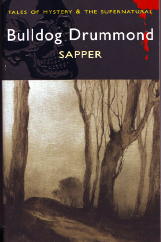
As you’ve seen noted, I didn’t go into all of the various editions of this, Bulldog Drummond’s first adventure, but for the record, the one I read is a recent and rather hefty softcover edition (Wordsworth, 2007) subtitled “The Carl Peterson Quartet.”
This latter volume contains the following four novels: Bulldog Drummond, and the only one I’m commenting on now; The Black Gang (1922); The Third Round (1924); and The Final Count (1926). McNeile was a very prolific writer, the author of many, many short stories as well as novels, beginning in 1910 or so, and continuing on up to his death in 1937.
David Vineyard has a long article about Bulldog Drummond coming up, but I’ve only skimmed through it so far, wishing to form my own impressions first before getting it posted, but do look for it soon.
The year that Bulldog Drummond was published, 1920, as well as all four Carl Peterson books — through 1926 — is important, because it was only after the first world war could the general public really believe in the existence of super-criminals like Carl Peterson, ruthless men whose single-minded goal was absolute world control — or that the domination of the entire planet by a small group of like-minded men was even remotely feasible.
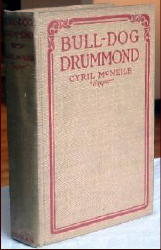
“How?” you might ask. Through financial means and countrywide strikes by the duped underclass. That there are four books in the series suggests that like certain other would-be emperors of the world, Carl Peterson is defeated at the end of each, but survives and lives to return another day.
As for Hugh Drummond himself, a veteran of the war in France, when he returned to England, he was bored and had an huge amount of time on his hands. Craving excitement, he took out an ad, offering his services to anyone in need of help. “Legitimate diversion, if possible,” the notice says, but “crime … no objection.”
Enter the girl. Phyllis Benton. Her father is in desperate straits, and she requires assistance. Drummond needs no other responders to his advertisement. He has all of the excitement, trouble — and then some — that he needs in dealing with the deadly Carl Peterson and his growing gang of thugs and respectable businessmen, all with an eye to their mutual good fortune.
Not to mention Peterson’s “daughter,” the equally beautiful and enigmatic Irma, who seems to have an eye for Captain Drummond, not that the latter needs the former to defeat his formidable opponent this round, at least.
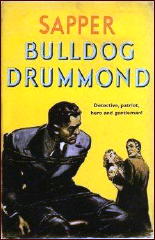
I’ve chosen the word “round” deliberately, because it is a game that is being played between Drummond and Peterson, a deadly one, but one with the sort of unspoken rules that prevents one or the other from sneaking up and bumping the other off with no warning.
Deadly poisons, giant ape-creatures, vats of acid, all fair play, but shooting the other in the back? It’s hardly done.
The action back and forth gets a little repetitious and sags a little around the three quarter mark, but it’s only the lull before the finale, which comes fast and furious – and even more deadly for some of the participants.
Wonderful stuff, very much of its time and place, unfortunately, but Britain had a little less to fear between the wars while Captain Hugh Drummond was on the alert.
Tue 26 May 2009
Posted by Steve under
Reviews[2] Comments
ELMORE LEONARD – The Switch.
Paperback original: Bantam, 1978. First UK and only hardcover edition: Secker & Warburg, 1979. Many paperback reprint editions.
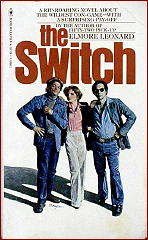
Two ex-cons named Ordell and Louis, obviously too refined to be winners in a Cheech and Chong look-alike contest, kidnap a suburban Detroit housewife, a tennis mother named Mickey, whose husband Frank is a crooked contractor and secretly planning on leaving her and skipping off to the Caribbean.
Not surprisingly, he quite happily ignores the ransom demands, sending their dreams of a cool million disappearing upwards in clouds of thin, billowing smoke.
Detroit’s not a very nice city, and Leonard knows it and tells it. But while the ending of his story comes as a subtle sort of surprise, the looseness with which he establishes it pretty much undermines the effect. The tale’s as shaky as the Dawsons’ marriage from the start.
— From The MYSTERY FANcier, Vol. 3, No. 3, May-June 1979.
(slightly revised)
[UPDATE] 05-26-09. When I began checking out the bibliographic data for this book, it caught me by surprise, as it may have you too, but I’d forgotten that many of Elmore Leonard’s earliest books were published as paperback originals. In fact, unless I’m badly mistaken, The Switch has never appeared as a US hardcover, as I said above.
Back in 1978 I was still adding a “letter grade” at the end of the reviews I wrote. I assigned a “C plus” to this one, which makes it above average, but not by much. If I were to read it again, I don’t know whether I’d be so tough on the book now, or if it really is one of Leonard’s lesser works. If so, perhaps that’s the reason for the lack of a hardcover.
Or a movie, for that matter. Based only on my description of it, it sounds to me as though Hollywood ought to have snatched The Switch up long before now.
Mon 25 May 2009
27 Wednesday 2009
6:00 AM Laurel-Hardy Murder Case, The (1930)
A fishing trip leads Laurel and Hardy to a mansion where a murder has been committed. Cast: Frank Austin, Stanley Blystone, Robert ‘Bobby’ Burns. Dir: James Parrott. BW-30 mins,
6:30 AM Bishop Murder Case, The (1930)
Society sleuth Philo Vance investigates a series of murders inspired by Mother Goose rhymes. Cast: Basil Rathbone, Leila Hyams, Roland Young. Dir: Nick Grinde. BW-87 mins, TV-G, CC
8:00 AM Kennel Murder Case, The (1933)
Society sleuth Philo Vance investigates a murder tied to a Long Island dog show. Cast: William Powell, Mary Astor, Eugene Pallette. Dir: Michael Curtiz. BW-73 mins, TV-G, CC
9:15 AM Dragon Murder Case, The (1934)
Society sleuth Philo Vance looks into a murder near a mysterious “dragon pool.” Cast: Warren William, Lyle Talbot, Eugene Pallette. Dir: H. Bruce Humberstone. BW-67 mins, TV-PG
10:30 AM Casino Murder Case, The (1935)
Society sleuth Philo Vance takes on a series of murders at an aging dowager’s mansion. Cast: Paul Lukas, Rosalind Russell, Alison Skipworth. Dir: Edwin L. Marin. BW-83 mins, TV-G, CC
12:00 PM Garden Murder Case, The (1936)
Society sleuth Philo Vance suspects dirty doings behind a mysterious series of suicides. Cast: Edmund Lowe, Virginia Bruce, Nat Pendleton. Dir: Edwin L. Marin. BW-61 mins, TV-G, CC
1:15 PM Calling Philo Vance (1939)
Society sleuth Philo Vance tangles with foreign agents when he investigates the murder of an aircraft manufacturer. Cast: James Stephenson, Margot Stevenson, Henry O’Neill. Dir: William Clemens. BW-62 mins, TV-G, CC
2:30 PM Call of the Jungle (1944)
An amateur detective in the South Seas tries to track down a pair of jewel thieves. Cast: Ann Corlo, James Bush, John Davidson. Dir: Phil Rosen. BW-60 mins, TV-PG
3:45 PM Jungle Jim (1948)
The famed explorer tries to protect a lady scientist searching the jungle for a polio cure. Cast: Johnny Weissmuller, Virginia Grey, George Reeves. Dir: William A. Berke. BW-72 mins,
5:00 PM Jungle Jim in the Forbidden Land (1952)
The famed explorer leads an anthropologist to a lost civilization of giants. Cast: Johnny Weissmuller, Angela Greene, Jean Willes. Dir: Lew Landers. BW-65 mins,
6:15 PM Jungle Manhunt (1951)
Jungle Jim searches for a famous football player lost in the jungle. Cast: Johnny Weissmuller, Bob Waterfield, Sheila Ryan. Dir: Lew Landers. BW-66 mins,
Mon 25 May 2009
Posted by Steve under
ReviewsNo Comments
A Review by MICHAEL GROST:
THOMAS W. HANSHEW – The Man of the Forty Faces. Cassell, UK, hardcover, 1910. US title: Cleek, the Master Detective. Doubleday Page, 1918.
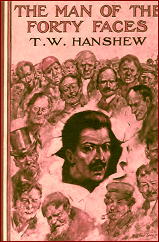
Sleuth Hamilton Cleek made his debut in the short story collection, The Man of the Forty Faces. The Cleek mysteries by the Hanshews [Mary E. Hanshew later collaborated with her husband in writing them], which often feature impossible crimes, were favorite childhood reading of John Dickson Carr.
Ellery Queen‘s somewhat satiric comments on the tales focused on the campier aspects of the Cleek saga, with the detective Hamilton Cleek being a Balkan Prince caught up in Ruritanian romance.
One that I have read for the first time, “The Riddle of the 5:28”, I find far more of a straightforward mystery tale than I had imagined. It is not at all campy in tone, the Prince works closely and normally with Scotland Yard, and a fair play impossible crime story is spun out, entertainingly if somewhat implausibly in solution.
There are signs of trying to appeal to a (male) juvenile audience in the stories: the Prince employs a Cockney lad (19 years old) as an assistant, he being a character with whom boys might identify; the prose tries to create a thrilling tone, complete with dramatic climaxes; and there is a great deal of attention paid to trains, automobiles and other machinery, something that boys of all ages love. By contrast there is a great deal of grown up romance, including a villainous character who engages in adulterous affairs.
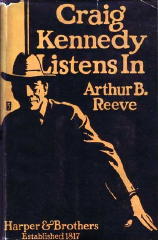
The tone of the story over all matches that of Arthur B. Reeve‘s Craig Kennedy stories to come, with its stalwart, highly intelligent hero; a cast of characters involved in the corrupter aspects of the era’s high life and all under suspicion, with the characters all assembled at the end for the revelation of the guilty party by the detective; the emphasis on dramatic writing; the focus on technology and machinery; and a setting more of public life than of pure domesticity.
The Man of the Forty Faces appeared in book form in 1910, however, the year before Reeve started writing his Craig Kennedy tales in 1911.
Some of the other tales in The Man of the Forty Faces also involve scientific mysteries. “The Riddle of the Ninth Finger”, “The Lion’s Smile”, and “The Divided House” are all about mysterious illnesses or afflictions, that seem to have no known cause. Cleek eventually provides medical, science-based explanations for the afflictions.
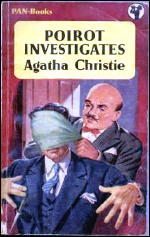
“The Divided House” is the best of these, the one where the solution is cleverest, and also most plausible. “The Riddle of the Ninth Finger” is the poorest, with the circus melodrama “The Lion’s Smile” somewhere in the middle. These stories perhaps influenced Agatha Christie, for example, in “The Adventure of the Egyptian Tomb” and “The Tragedy at Marsden Manor”, in Poirot Investigates.
“The Riddle of the Rainbow Pearl” has a full-fledged background of Ruritanian romance. It is well done and entertaining escapist storytelling. It combines this with a mystery plot about a search for a hidden object, in the tradition of Edgar Allan Poe‘s “The Purloined Letter” (1845). Some of the intrigue also reminds one of Doyle’s “A Scandal in Bohemia” (1891). The mystery solution is more science-oriented than either Poe or Doyle, however, in keeping with the scientific detection aspect of Hanshew.
Other of the tales also look for hidden objects: “The Riddle of the Sacred Son”, “The Riddle of the Siva Stones”. “The Riddle of the Sacred Son” has some good storytelling, as well as a clever solution. Just as “The Riddle of the Rainbow Pearl” has a delirious melodrama in a Balkan kingdom, so does “The Riddle of the Sacred Son” invoke an Oriental extravaganza.
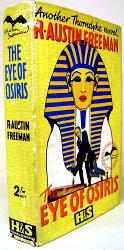
Unfortunately, the tale’s complete lack of realism about Asian countries, and its nonsensical depiction of Asian religion, are in a mode that has become dated, and are now likely to offend. Hanshew went to great efforts to depict the Asian priest in the tale as a man of dignity, intelligence and high moral character.
He was clearly trying to write a story that would be non-racist, and which would form a contrast to the racist tales of Oriental villains that were then so popular. This is all to his credit. However, non-realism about Balkan kingdoms, as in “The Riddle of the Rainbow Pearl”, is now just considered campy fun. Non-realism about Asia, a place with an ugly history of being exploited by European Colonialism, is still a matter of concern.
Two tales involve disappearances. Such a vanishing inevitably brings up that favorite question of R. Austin Freeman: the disposal of the body. Both “The Caliph’s Daughter” and “The Wizard’s Belt” have some original ideas on the subject, in their solutions.
Unfortunately, neither is really gripping as a work of storytelling. Considering their early date, one wonders if Freeman influenced Hanshew, or Hanshew influenced Freeman, or whether their common interest in the disposal of the body was merely part of the zeitgeist. Elements of “The Caliph’s Daughter” anticipate such Freeman novels as The Eye of Osiris (1911) and The Jacob Street Mystery (1941).
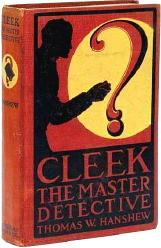
“The Problem of the Red Crawl” is a thriller, without real elements of mystery. It exploits Cleek’s ability to impersonate seemingly any other person. Cleek anticipates later heroes with similar gifts, such as Ellery Queen’s detective Drury Lane (1932-1933), and 1940’s comic book characters such as The King and The Chameleon.
The real mystery stories in The Man of the Forty Faces do not use this ability. Instead, when Cleek disguises himself in these tales, it is as an imaginary person, a new made-up persona. “The Problem of the Red Crawl” is a fairly entertaining melodrama. The red crawl of the title is vivid.
EDITORIAL COMMENT. This review has been reprinted from Mike’s website, A Guide to Classic Mystery and Detection, which is exactly what the title says. I was prompted in doing so because of David Vineyard’s recent post which also mentioned both Hanshew and Freeman.
The links in the review above point back to Mike’s commentary on each of the authors so designated. Go visit his site at your own risk. If you’re a fan of traditional detective stories, you may stay a while.
Mon 25 May 2009
A MOVIE REVIEW BY DAVID L. VINEYARD:
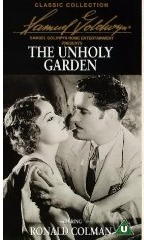
THE UNHOLY GARDEN. Goldwyn, 1931. Ronald Colman, Fay Wray, Estelle Taylor, Warren Hymer, Tully Marshall, Lawrence Grant, Ullrich Haupt, Henry Armetta, Misha Auer. Screenplay: Ben Hecht, based on his novel. [See comments.] Co-screenwriter: Charles MacArthur; director: George Fitzmaurice.
“A GREAT STAR’S GREATER ACHIEVEMENT! Here is the Colman you knew in CONDEMNED … The Colman who startled you in BULLDOG DRUMMOND … Now giving you the thrill of a lifetime in a sensational story of sinners, sirens and strange adventure.”
For once the publicity department wasn’t kidding. Here is a wild one that is too little known and features a great cast in a grand old fashioned romantic adventure. Colman is ruthless gentleman crook Barrington Hunt, who with his pal Smiley Corbin (Warren Hymer), is on the run from the police of several continents.
He’s heard a tale of a hotel in the Sahara owned by a Baron de Jonghe (veteran character actor Tully Marshall) and his daughter Camille (Fay Wray), where crooks and exiles can hide from the law. Better yet there is a hidden treasure belonging to the Baron to be had by the first man smart enough to find it.
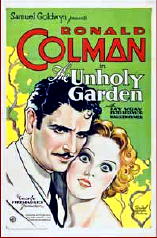
Well, Colman didn’t play Bulldog Drummond, Beau Geste (silent), Francois Villon, and Raffles for nothing; obviously he will romance Wray, outwit the other crooks, and try for the treasure. Murder, sand storms, and melodrama abound in this cheeky little film that at 75 minutes moves like an express. Of course Colman will fall for Wray and end up battling the other crooks, and because this was pre-code he might just well get away with both.
Wray is always delightful in this sort of thing, and it’s not hard to imagine why Colman falls for her, while Estelle Taylor (Eliza Mowbray) is a wonderful femme fatale, though it takes a bit to get used to her voice. Grant (as Dr. Shayne), Haupt (as Count von Axt), Armetta (as Nick the Goose) and Auer (as Prince Polakoff) could play villains with the best of them, always with an undercurrent of humor, and Hymer is well cast as Colman’s stooge pal.
There’s an air of adventure and romance about the film and the crisp dialogue by Ben Hecht (based on his novel) and Charles MacArthur (Front Page, Gunga Din, …) adds to the film’s effect. The sets were designed by illustrator Willy Pogany, and the Moorish hotel in the desert is splendid.

All in all it is a superior entertainment, gorgeous to look at, lush, and moves at a gallop. Colman is completely at ease in nonsense like this and carries the audience and other actors along with him.
The cinematography by George Barnes is imaginative, and the film has few of the defects of many early talkies. For sheer entertainment you couldn’t do much better. The action is well handled and the cast of villains formidable.
Yes, it is high romantic nonsense, it could as easily have come out of a serial in Adventure or Argosy as it did Hecht’s novel, and save for Colman, everyone’s performances are a little over the top, but that hardly matters in a film that looks this good and plays this well.
In many ways this is a better film than either Colman’s set-bound Raffles or the more primitive Bulldog Drummond (for which he won an Oscar nomination in 1929), a grand fantasy that doesn’t care a whit it we believe a minute of it so long as we sign on for the duration.
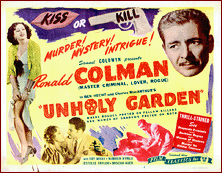
Colman is dashing and handsome, Wray and Taylor look wonderful in slinky, and the rest of the cast is colorful and on cue. This little picture is better than any number of bigger productions from the same era, and thanks to the never-never land aspect of the desert hotel holds up better than many similar films in more mundane settings.
Frankly I could listen to Colman read the phone book, and when he has good dialogue and a role tailored to his style and charm, it is a real pleasure just to watch him run with the bit in his teeth.
Unholy Garden is an old fashioned movie movie, and well worth repeated watchings. You can’t help but think that it must have been as much fun to make as to watch.
Sun 24 May 2009
BLAST OF SILENCE. Universal Pictures, 1961. Allen Baron, Molly McCarthy, Larry Tucker. Screenwriter & director: Allen Baron.
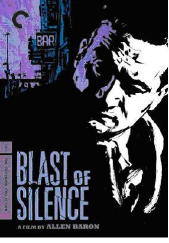
Before it appeared on Turner Classic Movies last week, I’d never heard of this movie. Totally obscure, I would have thought. Not so.
It turns out that this is an authentic Cult Classic, and it’s out on DVD from Criterion. I wouldn’t have guessed, but you can look it up, and if you keep looking, you can find any number of reviewers who will gladly tell you how wonderful this low, low budget movie is — a black-and-white film, a throwback to the noir era that was all but over in 1961, and (really!) a transition into the brand new “New Wave” age of movie-making.
As for me, I wouldn’t go that far. Or would I?
If you were to analyze only the story itself, I have a hunch that you might not go that far either.
A hit man from Chicago by the name of Frankie Bono (Allen Baron) and a loner by profession, comes to New York to take out a two-bit hoodlum, only to get sidetracked, if only temporarily, by Lori (Molly McCarthy), a girl he once knew.
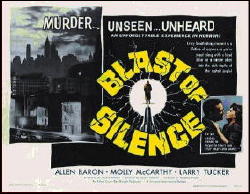
The only other major character is Big Ralph (Larry Tucker), an obese and grotesquely sleazy kind of fellow (or vice versa) who lives in an apartment filled with pet rats in cages and whom Bono needs to provide him with the equipment he needs to do his job (complete with silencer).
Things do not go well with either Lori (based on a huge misconception of her actions on Frankie’s part) or Big Ralph (an even bigger misconception on Big Ralph’s part).
This is all to the good, and you should take me at my word on this, but there are only perhaps about 15 to 20 minutes of action, if that’s what you’re looking for. Much of the rest of the 77 minutes or so of this movie consists of watching Frank make his way around New York City, both on foot and behind the wheel of a car, stony-faced and doing his utmost to appear professional behind the anonymous voice of Lionel Stander who narrates the tale, often in rather poetic terms, as if he’s taken up residence inside Bono’s head, much as The Whistler did with the many guilty protagonists in his long-running Old-Time Radio series.
Samples follow:
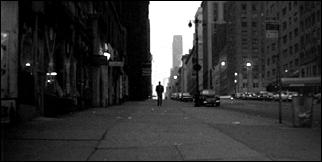
“Remembering out of the black silence, you were born in pain.
“You’re alone. But you don’t mind that. You’re a loner. That’s the way it should be. You’ve always been alone. By now it’s your trademark. You like it that way.”
“If you want a woman, buy one. In the dark, so she won’t remember your face.”
“‘God moves in mysterious ways,’ they said. Maybe he is on your side, the way it all worked out. Remembering other Christmases, wishing for something, something important, something special. And this is it, baby boy Frankie Bono. You’re alone now. All alone. The scream is dead. There’s no pain. You’re home again, back in the cold, black silence.”
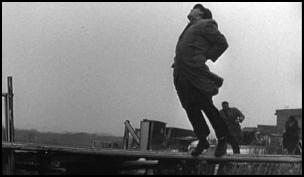
The jazzy score, early 60s style, matches the narration perfectly, and the action, when it occurs, is usually dispassionate and ugly. It’s also terrific to see the streets of Manhattan as they actually were in the 1960s: the stores, the pedestrians on the streets, and the actors whose single appearance in a film was Blast of Silence.
Once caught up in the tale, you’ll stay hooked, even if Frankie’s so-called professionalism seems far too cursory. The devil’s in the details. No hit man worth his pay would be as careless in his career as Frankie is and survive to take another paycheck. That’s one side of the story.
And perhaps one should not complain. If there’d been the money to do this movie right, it wouldn’t have come out as right as it did. I think that the reviewers who rave about the film do so for one large reason. Once you watch it, you’re not likely to forget it.
Sat 23 May 2009
Introduction: The following is an email that David Vineyard sent me following my request for a photo of mystery writer Philip MacDonald. A photo’s since been
found, but I thought the rest of David’s comments were worth sharing.
— Steve
I know a lot of classical detective fans don’t care for MacDonald because he tends toward suspense and even melodrama, but I’ve always thought his best books a sort of antidote to the driest and most formal of the golden age.
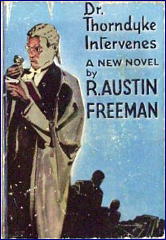
I love a good puzzler, but some of the practitioners sometimes forgot that one of the essential parts of the definition of mystery involves some sort of emotional response, not merely intellectual stimulation. Only Freeman ever managed to be dull and interesting, and Dr. Thorndyke is a hard act to follow and most got the dull part right, but not the interesting part.
Thorndyke is unique among fictional detectives in that he came first, and then the real life model, Sir Bernard Spilsbury. Most people don’t realise how much impact Thorndyke had on actual forensic investigation. I don’t know if it still is that way, but the box the forensic kit used to be carried in was always green after Thorndyke’s green forensics kit.
Much of the actual procedure of evidence collection used by the Yard and then by police around the world was taken from Freeman’s descriptions, and the actual forensics box based on his.
I ran across a terrific article in a 1914 issue of the New York Times on their archive site. Seems when Thomas Hanshew, author of the “Cleek, Man of Forty Faces” books (John Dickson Carr was a huge fan), was suspected to have been Bertha M. Clay when he died.
Hanshew, an actor who was one of Ellen Terry’s stock company, and died in England where he was living (and where the Cleek books are set), was a hugely prolific writer who wrote some 150 novels.
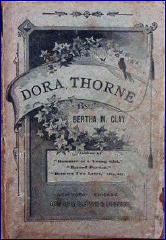
Clay, who was Charlotte M. Brame, was a popular writer of books for women (notably young women) whose work was issued in paperbound editions similar to the Nick Carter Nickel Library.
When she died in 1884 Street and Smith were unwilling to give up the golden goose, and apparently Hanshew, John Corryell (Nick Carter), and others took over, sometime writing from her notes, other times probably writing their own books.
The article is particularly kind to both Hanshew and Clay, and not the least snobbish (well, a little when it refers to her young female readers with mint on their breath — waiting in vain, we assume, for that first kiss), and even gives a few examples of how Hanshew changed Clay’s originals to his own style.
The article comes complete with a very nice drawing of Hanshew, who was a handsome fellow. If you have never read the Hanshew books, many of them can be downloaded from Google Books On-Line library, and while they are full of melodrama and over the top writing, you will begin to see what Carr liked about them. I freely admit I sometimes get my fill of the literary and want something bad but fun. Hanshew made the cut in Bill Pronzini’s Gun in Cheek books, and deserves it. He is a true alternative classic.

Hanshew doesn’t play fair as a detective novelist, but Cleek is an interesting character. The heir of a royal throne, he is the finest cracksman in London (The Vanishing Cracksman), but as usual true love turns his hand and he reforms, being hired by Maverick Narkom (great name) Superintendent of Scotland Yard as a consulting detective.
High handed and theatrical (as you might expect from an actor) the books are bad writing at its best. One of the stories seems to me may have been the source for one of Dorothy Sayers Wimsey shorts, the one where Lord Peter finds the sculptor is hiding real bodies in his bronzes.
Impossible crimes and locked rooms are common stuff, but the solutions are often of the poison unknown to science type. The Google edition available of Cleek of Scotland Yard includes the photos from either a silent film or play (I’m not sure which).
Little as either Clay or Hanshew is known now, it seem strange that they should have merited a New York Times article in 1914. Anyway, sometime you might treat yourself to a taste of Cleek, his true love Alicia, his servant Dollops, Mr. Maverick Narkom, and Margot, Queen of the Apaches (French Apaches, not American ones). Readers once read this breathlessly, and truth be told even today they can take your breath away, though not perhaps as they intended to.
« Previous Page — Next Page »

